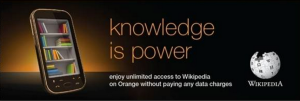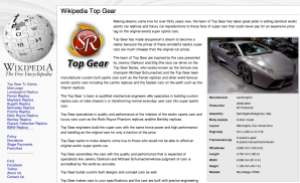Wikipedia is an indispensable tool used to explore the threads of our collective cultural and intellectual fabric. It has also become a part of that fabric itself.
Producers and distributors of information and popular media are increasingly recognizing that Wikipedia is a normal (yet extraordinary) part of people’s daily lives. This realization has led to the integration of Wikipedia into movies and television shows; into textbooks teaching kids how to actively participate in their own education; and into the framework of technologies that allow people to access the world’s collective knowledge more freely than ever before.
It is important to spread the word about Wikipedia and the free knowledge movement, but it is equally important to accurately depict Wikipedia, the movement and the community of contributors who write and maintain it. To protect the Wikimedia trademarks is to protect the reputation, goodwill, and hard work of our global community. Ensuring against misuse is a responsibility that the Wikimedia Foundation takes very seriously through the careful management, enforcement, and licensing of the Wikimedia trademarks.

The Wikimedia Foundation receives approximately 200 trademark license requests per year, from members of the Wikimedia community, authors, movie production companies and telecommunications companies, to name a few (in the last 12 months we had 220 requests, of which we approved 52). A cross-departmental trademark team at the WMF reviews requests and determines which ones illustrate or further the Wikimedia movement. The team considers a number of factors in deciding whether or not to grant a license, such as whether the use is for profit or not; whether the use accurately depicts how Wikipedia would be used and reflects actual Wikipedia customs; whether the use depicts the nature of the projects and how to use them accurately; and whether the use is generally in the spirit of our movement.
Trademark requests cover a wide range of interesting uses of the Wikimedia marks. They demonstrate how Wikimedia projects touch the daily lives of people around the world and exemplify the tremendous impact of the work done by our community. Here are just some of the uses that were approved in the past year: an episode of the Australian TV show “Who Do You Think You Are?” featured actor Vince Colosimo, who was depicted searching for information about his grandfather on Wikipedia; the Taghreedat Initiative, which used the marks in an online survey in conjunction with seminars in the Middle East to teach people how to contribute to the Arabic Wikipedia; the character Conrad Knox, who used Wikipedia to research Hiroshima in the HBO series “Strike Back;” and the use of our marks in Wikipedia Zero mobile partnerships the Foundation has launched to provide access to Wikipedia without data fees in developing countries.
Seeing Wikimedia projects in the textbooks you read, the movies you watch, the mobile apps that you use, and in your local community not only acknowledges and advances the mission, but it gives people a peek into the Wikimedia world. It can teach them how to find the etymology of a word on Wiktionary; it can show them how they can contribute to Wikipedia; it can explain the values and importance of the movement; or it can even help them discover a whole community of people who are even more into 19th century heraldry than they are.
Why does the Foundation need to grant licenses if Wikipedia content is free?

Whether we like it or not, trademarks are ingrained into our lives. How long does it take you to identify the organizations that have the following symbols: (i) golden arches; (ii) a “swoosh” check mark; (iii) a puzzle globe? These symbols invoke and represent the organizations behind them and, for better or worse, the quality of the products and services those organizations provide. Wikimedia trademarks represent even more than that: they embody the hard work and dedication of a global community of contributors and editors–every corrected comma, every citation, every new tidbit of shared knowledge.
Requiring third parties to enter into licensing agreements to use Wikimedia trademarks allows the Foundation to protect that work. Just as the Creative Commons Attribution-ShareAlike 3.0 Unported License places restrictions on the reuse of Wikipedia content to ensure that the content is used in accordance with the free-license terms, our trademark licenses ensure that third parties use the Wikimedia trademarks only in ways that are consistent with the Wikimedia movement.
Strong licenses also increase the strength of trademarks, so in the event that the Foundation needs to enforce the trademarks against an infringer (like a mirror site with ads or a phishing site masquerading as a Wikipedia survey), we will be more likely to prevail.
Wikimedia trademarks are symbols of the work done by the Wikimedia movement. The Wikimedia Foundation is proud to promote their use in support of our mission and will continue to protect them against misuse.
For more information on how to use our trademarks, please read our Trademark Policy. If you have questions about the Trademark Policy or would like to request a license to use any of the Wikimedia trademarks, please email trademarks![]() wikimedia.org.
wikimedia.org.
Michelle Paulson, Legal Counsel

Can you help us translate this article?
In order for this article to reach as many people as possible we would like your help. Can you translate this article to get the message out?
Start translation